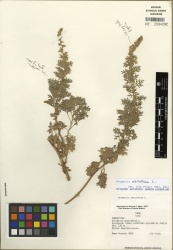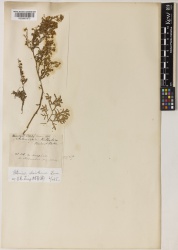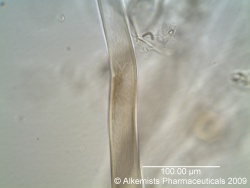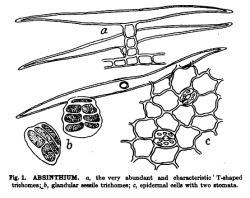|
AHPA recognizes other valuable resources exist regarding the identity of Artemisia absinthium.
To submit a suggestion or contribution, please contact Merle Zimmermann.
|
Nomenclature
Artemisia absinthium L. Asteraceae
Standardized common name (English): wormwood
Botanical Voucher Specimen
Organoleptic Characteristics
Scent Faintly aromatic, disagreeable and narcotic when briskly rubbed.
Flavor Very bitter, somewhat saline.
Source: Schneider, A. (1921) The Microanalysis of Powdered Vegetable Drugs, 2nd ed. [3]
|
|
|
|
Scent The plant has an aromatic odor.
Flavor [Wormwood has] an exceedingly bitter taste.
Source: American Medicinal Plants of Commercial Importance (1930) [4]
|
|
|
|
|
Macroscopic Characteristics
| This shrubby, aromatic, much-branched plant grows from 2 to 4 feet in height. The growing shoots are silvery white with fine silky hairs; and the grayish-green leaves, which are from 2 to 5 inches long, are divided into small leaflets. The flower clusers, appearing from July to October, consist of numerous small, insignificant, drooping, yellow heads.
Source: American Medicinal Plants of Commercial Importance (1930) [5]
|
|
|
|
|
Color Grayish green.
Source: Schneider, A. (1921) The Microanalysis of Powdered Vegetable Drugs, 2nd ed. [6]
|
|
|
|
|
Microscopic Characteristics
| The most distinctive tissue elements are the very abundant T-shaped, rather thin-walled trichromes with three to four basal cells; the rather large, yellowish, sessile, glandular trichromes with several vertical tiers of cells, are also quite diagnostic some pollen grains presenting the characteristics of the pollen of the order Compositae will generally be found. The vertical walls of the epidermal cells are wavy or sinuate and the stomata are abundant and fairly large.
Compare with Achillea and insect powder which are similar in certain of the histological characteristics.
Source: Schneider, A. (1921) The Microanalysis of Powdered Vegetable Drugs, 2nd ed. [7]
|
|
|
|
|
High Performance Thin Layer Chromatographic Identification
Supplementary Information
Sources
- ↑ MOBOT, Tropicos.org http://www.tropicos.org/Image/100158913
- ↑ Royal Botanic Gardens, Kew. http://specimens.kew.org/herbarium/K000891973
- ↑ Schneider, A. (1921) The Microanalysis of Powdered Vegetable Drugs, 2nd ed.
- ↑ American Medicinal Plants of Commercial Importance (1930)
- ↑ American Medicinal Plants of Commercial Importance (1930)
- ↑ Schneider, A. (1921) The Microanalysis of Powdered Vegetable Drugs, 2nd ed.
- ↑ Schneider, A. (1921) The Microanalysis of Powdered Vegetable Drugs, 2nd ed.
- ↑ Elan M. Sudberg, Alkemist Laboratories http://www.alkemist.com/
- ↑ Elan M. Sudberg, Alkemist Laboratories http://www.alkemist.com/
- ↑ Schneider, A. (1921) The Microanalysis of Powdered Vegetable Drugs, 2nd ed.






